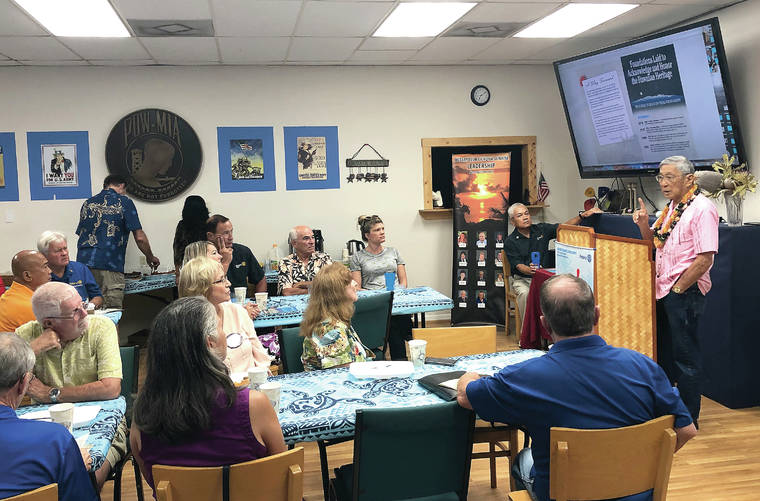KAILUA-KONA — Mayor Harry Kim remains steadfast in his commitment to finding a way forward as the standoff over the Thirty Meter Telescope on Maunakea continues.
“My goal is to get, through your help and everybody’s help, to have the people of this island and state to support what we want to do to make it better,” Kim told Rotary Club of Kona Sunrise members Wednesday morning. “My goal and vision, hope and dream is that … the protectors will understand the sincerity of what we are trying to do and they will also support it.
“Is it a pipe dream? I don’t believe in pipe dreams,” the mayor continued. “I believe if we work on it, we can do it.”
Kim’s proposal for finding resolution to the conflict is outlined in “Heart of Aloha — Maunakea: A Way Forward.” He put the pamphlet together and released it in late September, a couple of months after Gov. David Ige tasked him with negotiating with telescope opponents.
“I’m asking this group to really think about the issue beyond the Thirty Meter Telescope,” Kim told the several dozen Rotarians in attendance for the club’s weekly meeting. “This presentation is beyond a ‘yes’ or ‘no’ to the TMT project, this is about asking Hawaii’s people to come together to find a path to go forward in a good way — I didn’t put down ‘right’ way, I said a ‘good’ way.”
It took 115 drafts to perfect the booklet, which comprises 14 pages plus covers, Kim said. It is the result of many conversations and meetings during the past years with government leaders, guardians of the mountain, community, spiritual leaders, and scientists. His vision has remained relatively unchanged since he first spoke about it as mayor-elect in 2016 to the very same Rotary Club.
“This is over three years ago and nothing I said has changed,” Kim said, holding a copy of the 2016 West Hawaii Today article. “You know why? I don’t have to remember what I said — because you say what you know is right from the inside.”
The proposal lists a number of ways the state and University of Hawaii addressed grievances brought by the Hawaiian community and includes a vision for the future of Maunakea as an example to the world of a synthesis of culture and science. It also includes several timelines listing how the state improved upon issues related to Hawaiian culture and governance, such as how Hawaiian language education has expanded since 1978.
Included at the end are pledges from Kim, Ige, University of Hawaii President David Lassner, TMT Executive Director Ed Stone, Department of Hawaiian Home Lands Interim Director William Aila and the directors of the Maunakea Observatories, each one promising to commit to improve management and stewardship of the mountain.
Opponents have said they cannot agree with the proposal if it continues to allow the construction of TMT, estimated to cost $1.4 billion. Kim acknowledged that public statement.
“I wish it was not as strong as to that,” he said Wednesday, noting he hopes finding balance and understanding will surmount the differences. “I’m going to take a piece of the pie at a time. Hopefully, this will influence other people — including people who are of the Hawaiian group that are on the mountain. It’s going to take time and I’m asking the telescope people and governor’s office for time, and I realize the impatience of people.”
Protesters — who call themselves protectors, or kia‘i, of Maunakea — have occupied the Maunakea Access Road since mid-July. It began as opposition to the construction of TMT on a mountain considered sacred to some Hawaiians, but since expanded into a broader protest against state mismanagement of Hawaiian affairs.
Kim on Wednesday pointed to the need to understand how the opponents feel in order to find resolution.
He used as example the treatment of Hawaiians, particularly between 1893 through the 1970s and ’80s. From the overthrow of the Hawaiian Kingdom to the banning of speaking Hawaiian language and teaching Hawaiian culture in schools, it essentially told a portion of Hawaii’s population to “step aside.”
“Think about it if you’re Hawaiian,” Kim said, “just think about it and feel it for one minute.”
When asked about any movement in the standoff, the mayor said he sees “a lot of changes,” pointing to the various meetings hosted and pledges made. He, however, didn’t directly answer the question of whether any protesters seem interested to negotiate.
He also avoided answering directly a question about when protesters will be removed, noting that authority lies with the state. Meanwhile, the protest has entered its 19th week.
Kim stated, however, that he wouldn’t have assumed the role he did when asked by Ige if he didn’t think a resolution could be found.
“I wouldn’t be standing here if I didn’t think we had a chance to do this,” he said. “But, first we have to show that we understand some of the pain.
“We have to show that we not only understand, we commit to making it better.”
Email Chelsea Jensen at cjensen@westhawaiitoday.com.






